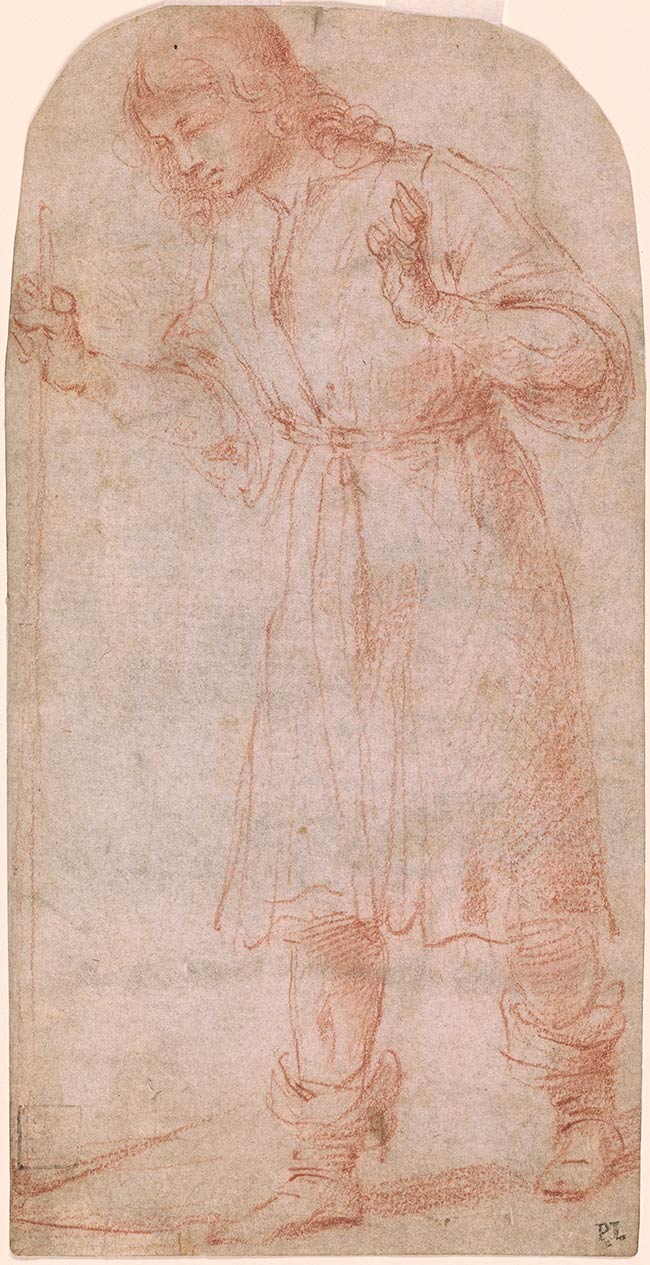

The drawing on the recto of this sheet is typical of Bachiacca’s figure studies in red chalk. It may be compared in particular to the preparatory studies that the artist made for the six panels that he contributed to the decoration of the bedroom of Pier Francesco Borgherini in Florence. The paintings in that cycle, which were commissioned by Salvi Borgherini to celebrate the 1514 marriage of his son Pier Francesco to Margherita Acciaioli, illustrate the life of the Old Testament patriarch Joseph and were executed around 1515–18 by Andrea del Sarto, Francesco Granacci, Jacopo Pontormo, and Bachiacca. The room was dismantled as early as 1584, and the pictures are now dispersed: four panels by Bachiacca are in the Galleria Borghese, Rome, and the two others are in the National Gallery, London.1
Fifteen figure studies by Bachiacca—nearly half of the artist’s known drawings—have been connected with the Borgherini cycle.2 The Morgan drawing is so similar in handling to these studies, and the morphology, pose, and costume of the figure are so comparable, that it is generally assumed to have been made in connection with that project even though it does not match any figure in the final paintings. It would thus date to the second decade of the sixteenth century. Similar figures leaning on a staff are found throughout Bachiacca’s work, however, even in late works like his tapestry designs from the 1550s. Although Bachiacca had received his artistic training under Perugino, red chalk drawings such as this reveal the influence of Bachiacca’s slightly older contemporary Andrea del Sarto.
Men leaning on staffs are, moreover, surprisingly frequent in Florentine paintings of the early cinquecento: they also appear, for example, in Granacci’s panels for the Borgherini bedroom. The figures probably derive from the common practice of drawing from live models leaning on supports to hold their pose.3 Having made such studies, that is, artists may have been inclined to include similarly posed figures in the crowds that populate many narrative compositions. Nonetheless, most of Bachiacca’s extant drawings correspond exactly to figures in finished works, and one suspects that the Morgan drawing may have also appeared in a work that is now lost.
The fragmentary study on the verso likewise finds no matching figure in a finished work, and La France states that “it displays instead elements of the heavy contours and elongated proportions of some attributed studio works.” La France suggests that the sheet was originally used by Bachiacca for the Borgherini commission but was then “turned over and re-used by Bachiacca’s shop at a later date.”4 This may be the case, but the differences from the recto to the verso could also result from the larger scale and different medium (black instead of red chalk) rather than from a different artist, for the pattern of hatching and even the distinctive shape of the hands seems consistent with that on the recto and in other drawings by Bachiacca himself.
—JJM
Footnotes:
- On the Borgherini bedroom, see especially Braham 1979.
- See La France 2008, 271–75.
- One instance of such a drawing, clearly a study of a live model, is the Morgan drawing by Timoteo Viti of a Male Nude Seated on Ground, Turned to the Right, inv. I, 13. Another such study by Viti is in the Städel Museum, Frankfurt, inv. 15851; see Frankfurt and Paris 2014–15, no. 15. On Viti, see also No. 33.
- La France 2008, 274.
Watermark: Three hills surmounted by a cross (similar to Briquet 11725: Florence 1423-24).
Lely, Peter, Sir, 1618-1680, former owner.
Reynolds, Joshua, Sir, 1723-1792, former owner.
Shatzki, Walter, 1899-1983, former owner.
Scholz, János, donor.
Rhoda Eitel-Porter and and John Marciari, Italian Renaissance Drawings at the Morgan Library & Museum, New York, 2019, no. 32.
Selected references: Washington and New York 1973- 74, no. 24; Colbert 1978, 191-92; Fellows Report 21 1989, 384; La France 2002, no. 129; La France 2008, no. 101.
Ryskamp, Charles, ed. Twenty-First Report to the Fellows of the Pierpont Morgan Library, 1984-1986. New York : Pierpont Morgan Library, 1989, p. 384.

